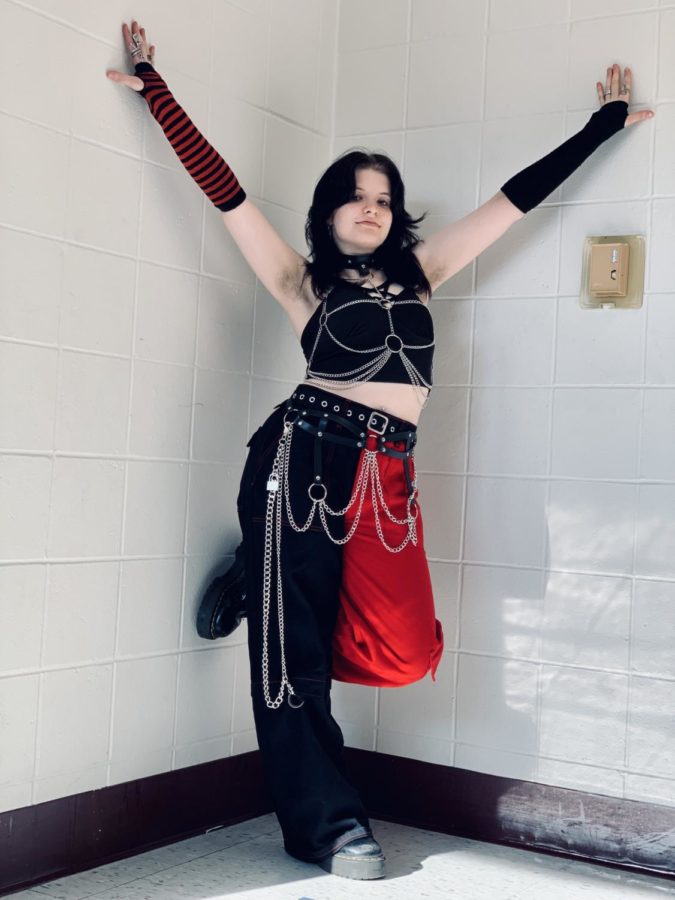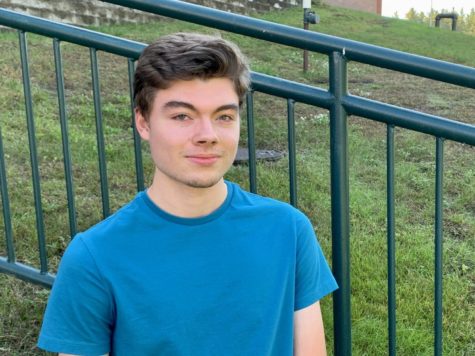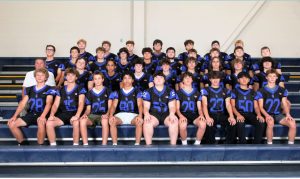Student’s Senior Quest Project Focuses on Mental Health Awareness and Resources at HBHS
Oakley Bazemore ’23, a strong mental health advocate, poses for a photo.
June 1, 2023
As a fierce advocate for mental health, especially when it comes to students, Oakley Bazemore, a senior at Hollis Brookline High School, chose to focus their Senior Quest project on this important issue. Their project aims to assess and organize what mental health resources are available at the school and to create an accessible list of them for both staff and students, as well as to reflect on what resources are lacking that the school could work towards for next year. Bazemore believes that since students spend so much of their time at school, it’s important that schools be able to provide students with the mental health resources they need.
“If someone is struggling, I believe that the school should be equipped to handle that, or maybe that person shouldn’t be in a building that can’t help them,” says Bazemore. “I’ve heard and witnessed a lot of complaints about our school’s lack of resources, but something’s always felt off — like the full truth was never there. So I took this project as a chance to look into it, and see what I could do to help. It’s no mystery that our school isn’t perfect, but our mental health systems are constantly changing and evolving — it’s just that lots of people in the building don’t know that. Before my project, I didn’t know it either.”
Bazemore’s main goal at the beginning of this project was to learn about all of the available resources the school offered inside the building, and according to Bazemore they’ve definitely reached that goal. Working on this project for the entire year, Bazemore was able to gather plenty of information and resources about mental health at HBHS. When asked to describe the mental health resources for students at school, Bazemore said they were “not as abundant as I would like, but it’s already much better than what we had even last year. There is still a lot of work to be done, but it was a relief to know that we have more available than I expected.”
Bazemore describes that working on a project about mental health can be very challenging, especially in the school systems.
“I’m not allowed to survey staff nor students even in casual and informal settings, and I’ve had to be very careful with what I say and do this whole time,” Bazemore said. “I still have to, to be honest.”
As a result, Bazemore has tried to keep everything strictly formal and as emotionally detached as possible, but when working with mental health, that’s nearly impossible to do. “The formal approach has been helpful, but it’s hard to not become emotionally invested when you are dealing with something so sensitive, you know?”
On a scale of 1-10, Bazemore says the mental health resources at the school would be a 6 or 7 based on availability to students and staff.
“It depends on what you’re looking for, and depends on how urgent things are. For example, we only have one SRO [Student Resources Officer], but we have a variety of counselors. So if it was something about college anxieties, it would be easier to access someone than if it was legal troubles, you know?” They said that within the last few years, HB has acquired more mental health–related staff, including a social worker and a new school psychologist, and the size of the guidance department has doubled. For students struggling with their mental health, Bazemore says that reaching out to any of these staff would be a helpful first step.
Bazemore has also found that mental health awareness among the majority of the staff has increased as well. For example, there is a new bulletin board on the second-floor staircase that talks about mental health.
“It mentions a lot of stigmatized aspects of mental health, and it makes my heart flutter just knowing it’s finally being talked about and is able to be up on a board and everything!” Bazemore exclaimed. “It makes me feel seen and heard, and I’ve had a lot of students share the same sentiments when I’ve brought it up in conversations.” The board is focused on breaking stigmas about mental health by expanding on what they are and how to identify them. For example, the board mentions stimming, also known as self-stimulating behaviors, and explains what it is and what it looks like.
Although HBHS has made several improvements with regards to mental health awareness, Bazemore feels the school still has a long way to go in terms of other improvements.
“We don’t have a designated space for students that need breaks and breathers, we only have one social worker that works for both the middle school and the high school, not all students are compatible with their counselors and aren’t aware that they are able to swap, mental health awareness can always be increased…. In short, there’s a lot of stuff HB can improve on, but I feel like that goes for most high schools.”
With the countless time and research Bazemore has put into advocating for mental health and working closely with HBHS to improve the mental health issues it faces, they offer some advice on how other schools can better assist those struggling to stay mentally healthy. Bazemore points out one thing HBHS has done particularly well is offering check-ins to students. They believe the reason these check-ins work so well is because they focus on listening and understanding, which helps students to feel comfortable discussing personal problems.
“A lot of students don’t feel heard nor understood, especially when they are struggling,” explains Bazemore. “Because of this, they stop trying to get help — why bother when it’s always the same thing, right?”
Actually asking someone what they want and listening to their requests and taking actions to make it happen is what Bazemore believes can go a long way.
Bazemore feels that the school is responsible to act in the student’s best interest, and although it may be difficult for schools to deal with mandatory reporting as at times it can lead to greater conflicts, it is important that schools take the responsibility to report and handle certain issues. Bazemore then added that both the community and the schools should share the responsibility of mental health.
“Schools are more convenient for getting help given how close and readily available they are for students, but there are only so many trained staff in a school that can help students — and each of those staff members have different roles with specific duties, too,” Bazemore explains. “If the help a student needs does not fall under these duties, then it’s time to turn to the community and the external resources that our school may refer to.” Although schools can be the first place for students to seek help with mental health issues, it’s also important for school staff to recognize when to refer a student to other resources outside the school, while also maintaining communication and check-ins with that student. A list of community mental health resources (mental health providers, local support groups, etc.) can be found on the HBHS counseling website.
Bazemore hopes that their project will educate students about the mental health resources available to them at HBHS, help them to access the resources with ease, and encourage the school to implement more mental health resources in the future. Before they graduate, Bazemore plans to compile the resources they’ve found and to leave suggestions for what else the school can work towards for next year. Bazemore’s work on this project inspired them to continue their mental health advocacy work after they graduate from HBHS.
For students seeking help with their mental health, Bazemore offers some final words of advice:
“Getting help is scary. Trust me, I know. Even now, admitting when I’m not doing okay can be terrifying. But if you don’t try to get help, you aren’t going to get it. Sometimes the help you get the first time won’t fix it, and it’s easy to get discouraged if that ends up happening. But giving up on getting help won’t solve things, and there are more people out there that want to help you than you know.”













![Students in Archaeology use tools in a mock excavation. As a class that focuses on hands-on learning, students are able to gain crucial life skills. “[The class] is more hands-on than I thought, and I'm learning way more with physical activities than I do in the classroom,” said student Tess Brown ‘25.](https://cavchronline.com/wp-content/uploads/2024/11/IMG_8390-e1733078359165-278x300.jpg)
